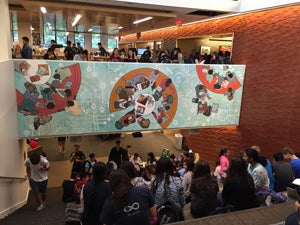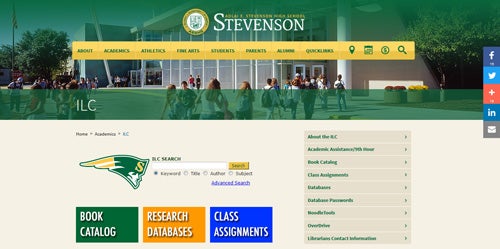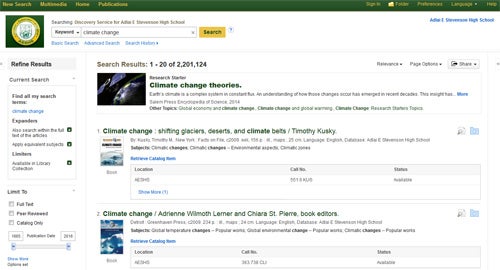
Overview
Located in the Chicago suburb of Lincolnshire, Illinois, Adlai Stevenson High School enrolls nearly 4,000 students in grades nine through 12. The Stevenson High School library ― known as the Information & Learning Center (ILC) ― aims not only to support the school’s curriculum but also to stimulate students’ intellectual curiosity and nurture a lifelong love of learning.
In 2015, the ILC began subscribing to EBSCO Discovery Service (EDS), a powerful research tool that allows users to search a library’s collection using a single search box. Branded as “ILC Search,” EDS uses single sign-on technology through OpenAthens. This means that students and faculty need to log in only once to access all of the library’s high-quality resources.
Since the tool officially launched in January 2016, students at Stevenson High School have been finding the information they need more quickly and easily, and the ILC is now seeing a healthier return on its e-resources investment.
Challenges
Over the years, to meet the demands of a constantly changing curriculum, Stevenson High School has purchased more and more library resources to support student research. As more databases were added, the more difficult it became to navigate the library website. Head Librarian Lisa Dettling created an alphabetical list of resources in an effort to help students find what they were looking for, but the list soon grew to include more than 100 databases.
“We have so many resources; we’re lucky in that way,” said Dettling. “But it was challenging. We spent a lot of time going through the databases with the students. Teachers don’t really want to give up that instruction time.”
Although Explora, EBSCO’s dedicated interface for schools, serves as an efficient one-stop shop for EBSCO databases, Dettling said she was interested in a search tool that would incorporate all of her library resources ― including the catalog and dozens of Gale databases ― in one universal search.
EBSCO Discovery Service (EDS) proved to be the tool to do just that.
Solutions
EDS was launched as “ILC Search” in January 2016. A single search box is positioned front and center on the library website’s home page.

“Students love searching in one place,” Dettling said, adding that she touts ILC Search as the Google for Stevenson High. “Having the EDS search box takes the guessing out of database selection. […] It allows students to focus on what matters ― the quality and varied resources necessary to do any research.”
Students can target their initial searches by selecting among four radio buttons; keyword is the default, but they can also choose to search by title, author or subject. Once the results page loads, Dettling points students to the Research Starter that appears at the top of the list. Available for thousands of popular topics, Research Starters provide summary articles with the background information students need to begin their research.
“I love the Research Starters,” Dettling said. “It is a great buy-in for students who know nothing about a topic they need to research. We ‘sell’ the Research Starters as the Stevenson version of Wikipedia. Students find great overview articles from reliable resources that Stevenson owns.”

Once students have a better understanding of their topic, they can begin to narrow their search results. Dettling recommends adjusting the publication date and using additional filters, such as source type, to zero in on the most relevant articles. Once the number of results is more manageable, she draws students’ attention to the preview icon, which allows them to see the article abstract.
“If they see the abstract, they can determine whether the article is going to be good,” Dettling explained, adding that the article preview also helps students identify other subject terms. “Going in by subject ― that’s a beautiful thing. You can’t do that with Google. [EDS] gives you a much more efficient way of culling your results.”
In addition, since Stevenson High School uses NoodleTools for research projects, the permalinks in EDS make it very easy for students to go back to the resources they find.
Benefits & Results
Dettling said use of the library’s resources has risen significantly since introducing ILC Search. From January to April 2016, the library saw nearly 33,000 full-text downloads, more than double the 14,000 downloads seen from September to December 2015.
“Our usage statistics are off the charts,” Dettling said, noting that March ― a busy month for the library ― saw the highest number of full-text downloads with 13,000. “This is only the first year; we’ll see more use next year.”
So far, students are experiencing success with ILC Search.
“I had a junior tell me during research that ‘it is better than Google,’” Dettling said. “Another student told me, ‘This is awesome.’ I’m not exaggerating. I’ve been taking a little survey at the end of class, and they say they love it. It’s a lot of results, but once you show them how to go in there and reduce their results, they get it.”
Perhaps the greatest benefit to using EBSCO Discovery Service, Dettling said, is that students are becoming familiar with the kind of research tool they will encounter in colleges and universities around the world.
“We asked EBSCO to tell us which colleges and universities in our region have gone to this model, and they sent me a list,” Dettling said, citing Southern Illinois University Carbondale and Indiana University as examples. “These are schools our kids go to. I tell them, ‘You’re going to start seeing this more and more. If you get used to it now, you’ll be very comfortable in college.’”